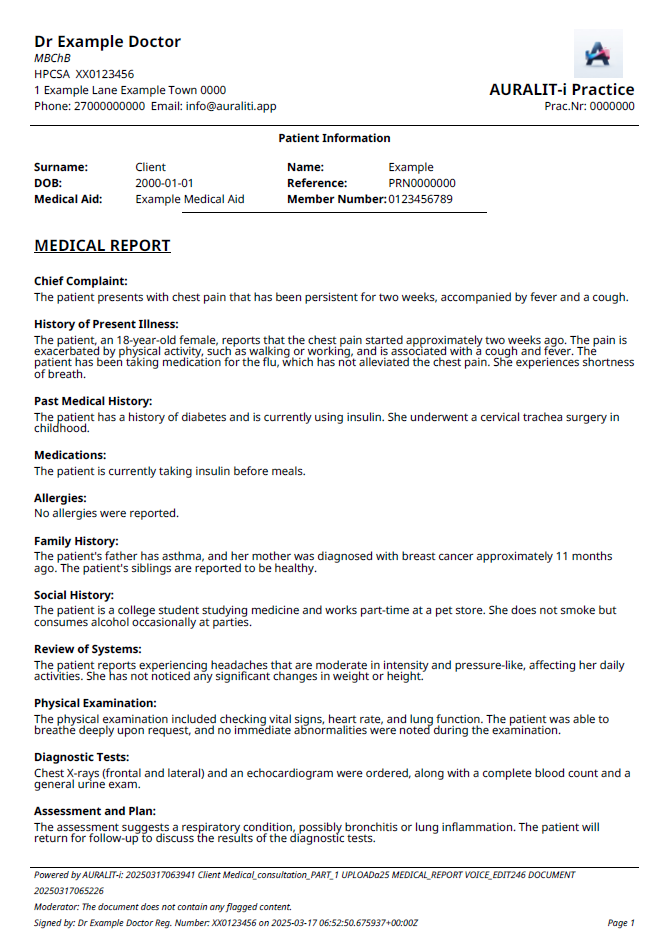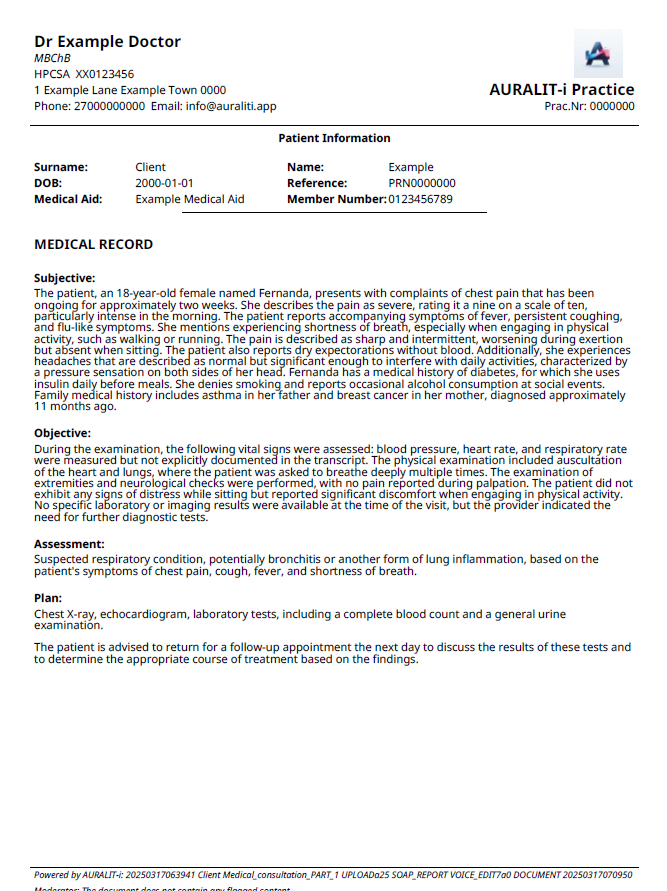Document Information
A comprehensive report capturing patient details such as chief complaint, medical history, examination findings, diagnostics, and treatment plans. Ideal for general consultations, follow-ups, and documenting patient encounters.
What Information It Includes
- Chief complaint and history of present illness (HPI)
- Relevant past medical history (PMH) and diagnosed conditions
- Medications, allergies, family and social history
- Physical exam details, test results, and treatment plans
How to Improve
- Be Specific: Clearly state the patient's chief complaint (e.g., 'Patient presents with a 3-day history of severe abdominal pain').
- Detail Medical History: List relevant medical history and chronic conditions (e.g., 'PMH: Hypertension, Type 2 Diabetes').
- Medication Clarity: Provide specific medication names, dosages, and frequencies (e.g., 'Medications: Lisinopril 10mg daily, Metformin 500mg BID').
- Exam and Plan: Summarize exam findings and recommended next steps (e.g., 'Physical Exam: Abdomen tender to palpation in the RLQ. Plan: Order CT scan of the abdomen and pelvis').
- Use Medical Terminology: Ensure accuracy by using correct medical terms.
- For Conversational Input:
- Clarify Patient Statements: If the patient's description is vague, ask clarifying questions (e.g., 'Can you describe the pain more specifically?').
- Summarize Key Points Aloud: Periodically summarize key information (e.g., 'So, to recap, you've had this pain for three days, and it's worse after eating?'). This reinforces the information for the report and the patient.
- Explicitly State Findings: After an examination, state your findings aloud (e.g., 'On examination, I noted tenderness in the lower right quadrant').
- Clearly Outline the Plan: Verbally lay out the plan for the patient (e.g., 'We'll order a CT scan, and I'd like you to follow up in a week').
Frequently Asked Questions
No, only positive and relevant negative findings mentioned in the audio is noted. For instance, if there's no information on family history, the section will be omitted.
Yes, mention them in the audio (e.g., 'Lab results: WBC 15,000, Hemoglobin 12.0'). They will appear under 'Diagnostic Tests'.
Be specific, state 'No known allergies for antibiotics' or 'Patient denies any allergies' explicitly.
Yes, even a short note like 'Family History: Mother with history of breast cancer' will be included.
Dictating allows for more structure, but recorded conversation captures what was mentioned in the consultation. Each section of the report will automatically be populated with the relevant information.
A structured SOAP (Subjective, Objective, Assessment, Plan) medical note, ideal for organizing patient encounters and documenting clinical reasoning. Useful for progress notes, daily rounds, and outpatient visits.
What Information It Includes
- Subjective: Patient's complaints, symptoms, and history
- Objective: Observable data, vital signs, test results
- Assessment: Clinical evaluation and diagnoses
- Plan: Treatment steps, orders, follow-ups
How to Improve
- Separate Subjective and Objective: Clearly differentiate patient statements from objective measurements (e.g., 'Subjective: Patient reports headache. Objective: BP 140/90').
- Detail Physical Exam: Include specific physical exam findings (e.g., 'Objective: Lungs clear to auscultation, abdomen soft and non-tender').
- Comprehensive Assessment: Summarize the final assessment with diagnoses or working hypotheses (e.g., 'Assessment: Possible migraine vs. tension headache').
- Actionable Plan: Outline the plan with clear prescriptions, lifestyle changes, and follow-up instructions (e.g., 'Plan: Prescribe Ibuprofen 600mg PRN, follow up in 1 week').
- Quantify whenever possible: 'Objective: edema 2+ pitting' is better than just 'edema'.
- For Conversational Input:
- Directly Address SOAP Sections: As you gather information, mentally categorize it into SOAP sections. You can even say aloud, 'So, subjectively, you're describing...'.
- Confirm Objective Data: When taking vitals or observing findings, state them clearly (e.g., 'Your blood pressure is 140/90, which is elevated').
- Verbalize Your Assessment: Articulate your thought process (e.g., 'Based on these findings, my assessment is that this could be...').
- State the Plan Clearly: Ensure the patient understands the plan (e.g., 'For the plan, we'll start with this medication and schedule a follow-up').
Frequently Asked Questions
List each issue under Subjective and Objective, then consolidate them in the Assessment (e.g., 'Assessment: Multiple complaints, likely related to anxiety').
Yes, mention them with specific values (e.g., 'Objective: Chest X-ray shows no infiltrates').
Document your differential diagnoses or working hypotheses (e.g., 'Assessment: Differential includes pneumonia, bronchitis').
While adaptable, a dedicated 'Surgery Report' might be more suitable for detailed surgical documentation.
A formal letter to another healthcare provider, summarizing the patient's condition and the reason for referral. Essential for coordinating patient care and ensuring continuity of treatment.
What Information It Includes
- Patient's background and relevant medical history
- Current presentation, symptoms, and diagnostic findings
- Specific reason for referral and requested services
How to Improve
- Clarity of Purpose: Clearly state the reason for referral and the specific expertise needed (e.g., 'Referral to cardiology for evaluation of persistent chest pain').
- Comprehensive Summary: Provide a concise but thorough clinical summary (e.g., 'Patient with a history of hypertension and hyperlipidemia presents with...').
- Specific Requests: Outline any specific tests, procedures, or consultations needed (e.g., 'Request for cardiac stress test and echocardiogram').
- Contact Details: Ensure your contact information is included for easy communication and feedback.
- For Conversational Input:
- State Referral Intent Clearly: During the consultation, state your intention to refer the patient and the reason (e.g., 'Based on these findings, I'm going to refer you to a cardiologist').
- Summarize Relevant History Aloud: Briefly summarize the patient's relevant history and current presentation (e.g., 'This patient has a history of... and is now presenting with...').
- Explicitly Mention Requested Services: Clearly state what you're requesting from the specialist (e.g., 'I'm requesting an evaluation for... and a possible...').
- Confirm Key Details with Patient: Ensure the patient understands the referral and the reasons behind it.
Frequently Asked Questions
Yes, clearly articulate each reason in the transcript.
Yes, relevant results support the referral and provide context.
Use 'Dear Colleague' or 'To the [Specialty] Department' if you don't have a specific name.
The letter should include a heading (e.g., 'RE: Patient Referral'), an introduction, relevant history, the referral request, and a closing.
This depends on your system. If possible, mention the attached results in the letter. If not, make sure they are included in the patient's record and accessible to the specialist.


